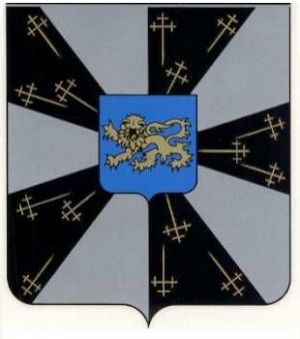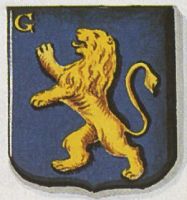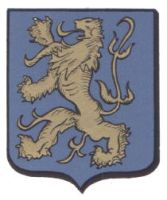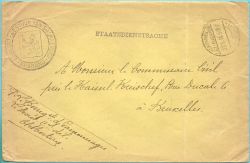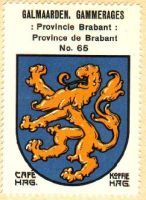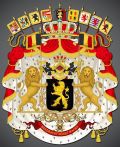Galmaarden: Difference between revisions
Knorrepoes (talk | contribs) |
Knorrepoes (talk | contribs) No edit summary |
||
| Line 35: | Line 35: | ||
</gallery> | </gallery> | ||
The first arms showed the lion with a small letter G in the upper right corner, which, however, was not mentioned in the blazon. The colours were the Dutch national colours, as in 1813 the mayor applied without indicating the colours. The arms were thus granted in the national colours. When the arms were confirmed after the Belgian independence, the colours were not changed. In 1908 the arms were changed and the small G was removed. Still the old arms were used until at least | The first arms showed the lion with a small letter G in the upper right corner, which, however, was not mentioned in the blazon. The colours were the Dutch national colours, as in 1813 the mayor applied without indicating the colours. The arms were thus granted in the national colours. When the arms were confirmed after the Belgian independence, the colours were not changed. In 1908 the arms were changed and the small G was removed. Still the old arms were used until at least the 1960s... (see images below) | ||
The oldest known seal of the local council dates from the late 14<sup>th</sup> century and shows a leopard. The later seals also show the leopard. Why the leopard was changed into a lion in 1818 (and again in 1908) is not known. The origin of the arms is not clear. Of the families that ruled the town from the late 14<sup>th</sup> century and later, many used a lion, but none a leopard. It is therefore likely that the arms are derived from the arms of the oldest Lords of Galmaarden, whose arms, unfortunately are no longer known. | The oldest known seal of the local council dates from the late 14<sup>th</sup> century and shows a leopard. The later seals also show the leopard. Why the leopard was changed into a lion in 1818 (and again in 1908) is not known. The origin of the arms is not clear. Of the families that ruled the town from the late 14<sup>th</sup> century and later, many used a lion, but none a leopard. It is therefore likely that the arms are derived from the arms of the oldest Lords of Galmaarden, whose arms, unfortunately are no longer known. | ||
| Line 44: | Line 44: | ||
<gallery widths=250px heights=200px perrow=0> | <gallery widths=250px heights=200px perrow=0> | ||
File:Galmaardenc.jpg|alt=Wapen van Galmaarden/Arms (crest) of Galmaarden|Municipal cover (1916) with the 1818 arms | File:Galmaardenc.jpg|alt=Wapen van Galmaarden/Arms (crest) of Galmaarden|Municipal cover (1916) with the 1818 arms | ||
File:Galmaardenc1.jpg|alt=Wapen van Galmaarden/Arms (crest) of Galmaarden|The arms on a municipal cover (1960s) with the 1818 arms (!) | |||
File:galmaarden.hagbe.jpg|alt=Wapen van Galmaarden/Arms (crest) of Galmaarden|The arms in the [[Koffie Hag Belgium|Koffie Hag/Café Hag albums]] +/- 1930 | File:galmaarden.hagbe.jpg|alt=Wapen van Galmaarden/Arms (crest) of Galmaarden|The arms in the [[Koffie Hag Belgium|Koffie Hag/Café Hag albums]] +/- 1930 | ||
</gallery> | </gallery> | ||
Latest revision as of 05:11, 24 September 2023
|
Country : Belgium Province : Vlaams-Brabant Additions:
|
| Dutch |
|
| English | blazon wanted |
Origin/meaning
The first arms were granted on arms were granted October 31, 1818, changed on July 27, 1908 and again after the merger with the other municipalities on December 2, 1985.
The first arms showed the lion with a small letter G in the upper right corner, which, however, was not mentioned in the blazon. The colours were the Dutch national colours, as in 1813 the mayor applied without indicating the colours. The arms were thus granted in the national colours. When the arms were confirmed after the Belgian independence, the colours were not changed. In 1908 the arms were changed and the small G was removed. Still the old arms were used until at least the 1960s... (see images below)
The oldest known seal of the local council dates from the late 14th century and shows a leopard. The later seals also show the leopard. Why the leopard was changed into a lion in 1818 (and again in 1908) is not known. The origin of the arms is not clear. Of the families that ruled the town from the late 14th century and later, many used a lion, but none a leopard. It is therefore likely that the arms are derived from the arms of the oldest Lords of Galmaarden, whose arms, unfortunately are no longer known.
The current arms show the arms of the Lords of Enghien/Edingen with an escutcheon with the leopard from the historical arms of Galmaarden. The arms of Enghien were used by Vollezele. The oldest known arms of a Lord of Galmaarden dates from 1280, for Walter de Braine, showed also the Enghien arms, as he was a descendant of the latter family.
Image gallery
The arms in the Koffie Hag/Café Hag albums +/- 1930
Literature: Servais, 1955
Belgium heraldry portal
This page is part of the Belgium heraldry portal |
Heraldry of the World |
|
Civic heraldry:
|
Other heraldry: |
Contact and Support
Partners:
Your logo here ?
Contact us
© since 1995, Heraldry of the World, Ralf Hartemink 
Index of the site
